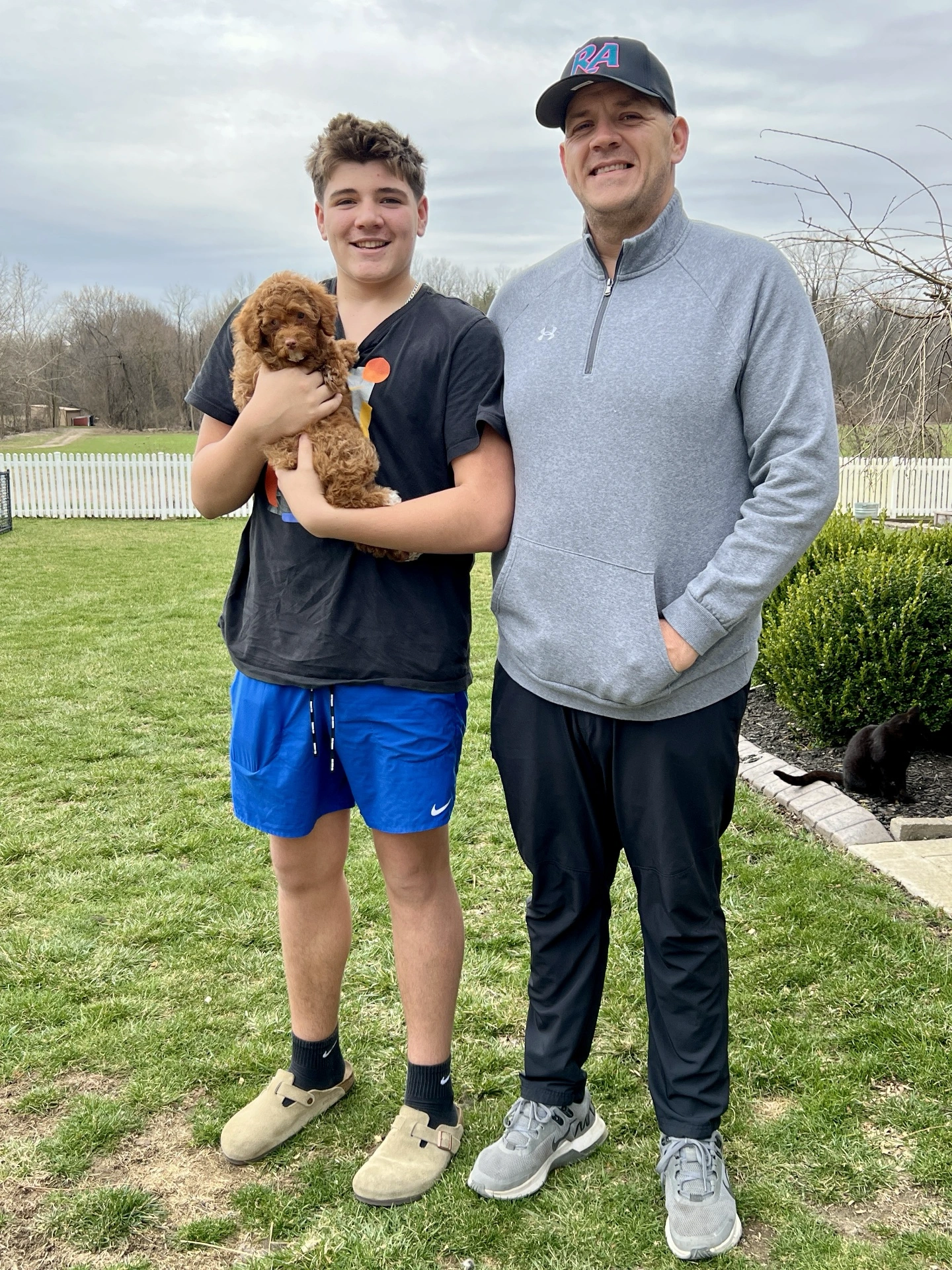Aside from perhaps Bernedoodles or Labradoodles, Goldendoodles are one of the most popular poodle breeds in the world. What makes them even more popular is the fact that you can purchase them in multiple sizes – mini, medium, or large.
If you aren’t sure which Goldendoodle size is right for you and want to know more about how big they get, you’ve come to the right place. While this article will focus on Mini Goldendoodles, we’ll also discuss the different size options, including how big each respective Goldendoodle typically gets.

How do you get a Mini Goldendoodle?
A Goldendoodle is a cross between a poodle and a Golden Retriever, and you get it by breeding the two species together.
Contrary to what you might think, the best way to produce a Mini Goldendoodle isn’t to breed together a small poodle and a Golden Retriever. In most cases, this will still produce a mini to medium size offspring.
Instead, the best way to get a true Mini Goldendoodle is to breed two miniature Goldendoodles together. You can also breed a miniature poodle to a mini or medium Goldendoodle, or a toy poodle to a small Golden Retriever.
However, unless you breed two Mini Goldendoodles together, there’s always a chance that you’ll end up with mini to medium puppies.
How popular are Mini Goldendoodles to other designer breeds?
Mini Goldendoodles are easily one of the most popular breeds in the United States, even when compared to other designer breeds.
A designer breed is any type of dog mix where you intentionally breed two dogs to create a specific type of puppy.
Because of their small stature and playful nature, Mini Goldendoodles are at the top of this list in terms of popularity.
What percentage of customers prefer standard Goldendoodles over Mini Goldendoodles?
At Fawn River Doodles, we sell a ton of miniature and medium Goldendoodles. As with the rest of the country, most of our customers are on the Mini Goldendoodle bandwagon.
As such, only 20 to 25% of our customers prefer standard Goldendoodles over their miniature cousins.
While standard Goldendoodles aren’t as popular as mini, medium Goldendoodles come in at a close second.
Medium Goldendoodles are anywhere from 40 to 55 pounds and are the perfect compromise when you can’t decide between mini and standard.
Therefore, it’s only fitting that they’re also right between mini and standard Goldendoodles in terms of popularity.
What’s the price range for Mini Goldendoodles?
Although Mini Goldendoodles are small in stature, they carry a fairly sizable price tag. On average, you should expect to pay anywhere between $2,000 and $5,000 for a Mini Goldendoodle, depending on where you purchase it, the colors, and other factors.
While this is slightly less than at the height of puppy prices during Covid, it’s still significantly higher than pre-Covid prices.
Inflation has a big role to play in these higher prices, as it costs more for breeders to produce and care for large litters of puppies, which means they need to charge more per pup.
How do you know how big puppies will be as adults?
Knowing how big a litter of puppies will be as adults is always difficult. The best way to take the guesswork out of the equation is to breed two similarly sized dogs together.
In other words, if you breed two standard doodles together, you’ll most likely end up with standard-sized adult dogs. Similarly, if you breed two mini doodles together, you’re most likely to end up with true Mini Goldendoodles that remain less than 35 pounds heavy as adults.
How many puppies do Goldendoodles typically have in a litter?
As with poodles and Golden Retrievers, Goldendoodles typically have 6 to 10 puppies per litter. However, this can vary greatly depending on the dogs in question.
Some litters can be as small as one or two, while others can be as large as 12. The most we’ve seen at Fawn River Doodles is 10, but I’ve heard of larger litters from other breeders.

What’s the typical weight of Mini Goldendoodles at different growth stages?
Although it isn’t set in stone, here’s the typical weight progression of Mini Goldendoodles as they grow:
- 8 weeks – 5 to 7 pounds
- 4 months – 15 pounds
- 1 year – 30 to 35 pounds
It’s at the 1-year mark that Mini Goldendoodles are safely considered full-grown, but most of them stop growing around the 9 to 11-month mark. Once again, this can vary from pup to pup, but it’s a pretty safe average of what you can expect.
At what age do you send puppies home with their owners?
We understand that you will want to take your mini doodle to their furever home as early as possible.
However, our standard policy is to let Mini Goldendoodles go home with their owners when they’re eight weeks old.
Additionally, if you’re willing to wait a little longer, we’ve found that sending them home at 10 or 11 weeks old is even more beneficial for the puppy.
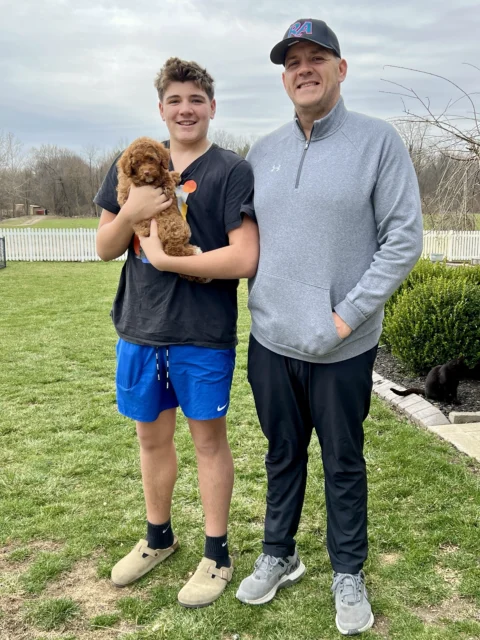
When do Mini Goldendoodles start to calm down?
All Goldendoodles, but especially minis, are known for their hyper personalities. Luckily, you can expect your Mini Goldendoodle to start calming down as they grow into adulthood. In most cases, this is around the 12 to 15-month mark, but some will remain energetic their entire lives.
Is the smallest puppy in the litter always the smallest adult?
Although they might be the runt when they’re born, the smallest puppy in the litter isn’t always the smallest adult. While this can sometimes be the case, we’ve also seen instances where the runt of the litter ends up being the biggest adult compared to the rest of its siblings.
What are the different types of Mini Goldendoodle generations?
As with other Goldendoodles, there are four basic types of Mini Goldendoodle generations to choose from. These generations include:
- F1 – A poodle bred to a retriever.
- F1B- When one parent is an F1 Goldendoodle and the other parent is a poodle.
- F2 – Two F1 Goldendoodles bred together.
- Multi-generational – A mixture of any of the above breeds to one another, where both parents are some type of Goldendoodle.
While each of these generations is popular, multi-generational Goldendoodles are our most popular. Generation has nothing to do with size or how big a Mini Goldendoodle will get, but rather refers to how much poodle blood is in each Goldendoodle.
Do Mini Goldendoodles shed?
One of the main reasons that Mini Goldendoodles are so popular is because the very little they shed. In fact, most Mini Goldendoodles don’t shed at all, except during bath time or if you’re brushing them.
The exception to this rule is that mini doodles will shed a bit more as puppies until they’re full-grown and have their adult coat.
However, while all Goldendoodles are considered hypoallergenic and non-shedding, there’s always a chance that this won’t be the case. As a general rule, the more poodle blood a Goldendoodle has, the less likely they are to shed.
Therefore, F1 Mini Goldendoodles are the most likely to shed a bit, while F1B and multigenerational doodles are the least likely. This is similar to Bernedoodles, Labradoodles, and other mixed poodle breeds.
What health problems do Mini Goldendoodles typically have?
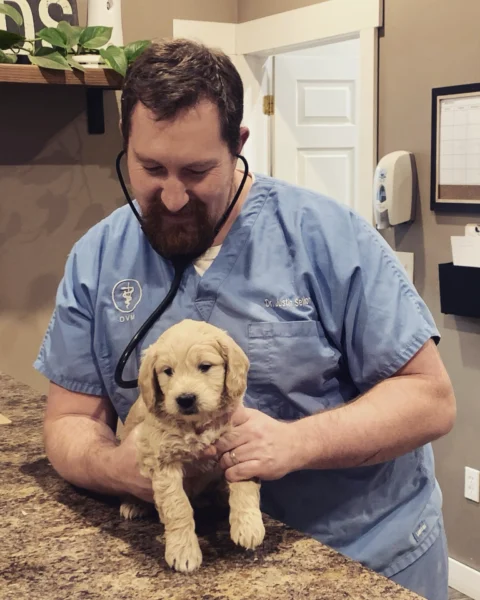
Because of their smaller size and stature, Mini Goldendoodles aren’t as prone to health issues as medium or standard Goldendoodles. However, they do have their fair share of health problems to watch out for, including:
- Hip dysplasia: A malformation of the hip joint that can lead to pain and stiffness.
- Allergies: Both Golden Retrievers and Poodles are prone to allergies, which can manifest as skin problems, ear infections, and respiratory issues.
- Otitis media: Ear infections are a common problem in Goldendoodles due to their floppy ears.
- Hypothyroidism: A hormonal disorder that can cause weight gain, lethargy, and hair loss.
- Progressive retinal atrophy (PRA): An eye disease that causes gradual loss of vision.
- Aortic stenosis: A heart condition that narrows the aortic valve, leading to heart murmurs and reduced exercise tolerance.
- Luxating patella: A condition where the kneecap dislocates, causing pain and limping.
- Von Willebrand’s disease: A bleeding disorder that affects the blood’s ability to clot.
- Gastric dilation volvulus (GDV or bloat): A life-threatening condition where the stomach twists and fills with gas.
Other potential health problems to watch out for include obesity, diabetes, cataracts, and sebaceous adenitis, which is an autoimmune condition that leads to hair loss, scaling, and other skin issues.
However, you can prevent most of these problems by purchasing a Mini Goldendoodle whose parents have undergone genetic testing.
This is something we do at Fawn River Doodles because it keeps us from breeding two dogs that could have pups with genetic diseases and health problems.
What exercise routines work best for Mini Goldendoodles?
The best way to ensure your Mini Goldendoodle gets the exercise it needs is to take them on two to three walks per day. Or, if you have a fenced-in yard, you can let them run around for several hours per day.
Additionally, you should take them to dog parks occasionally so they can interact with other pups. The more exercise your dog gets, the less prone they will be to obesity and other exercise-related health problems.

Do Mini Goldendoodles actually require a different exercise routine than standard Goldendoodles?
In general, Mini Goldendoodles don’t require a different exercise routine than standard Goldendoodles. On average, they may require slightly less exercise, since they have smaller bodies and less stamina than standard doodles, which means shorter walks and fewer trips to the park.
Do Mini Goldendoodles require more hands-on training than other breeds?
Based on my experience as a professional dog breeder, I haven’t found it to be true that Mini Goldendoodles require more hands-on training than other breeds.
If anything, they may require less, due to their high level of intelligence and eagerness to please. However, they still require plenty of attention and training if you want them to be obedient and well-behaved pups.
What is your personal grooming routine recommendation for Mini Goldendoodles?
At Fawn River Doodles, we deal with dozens of Goldendoodles of every size. As such, we’re well-informed when it comes to what grooming routine works best for them.
We recommend brushing them anywhere from two to seven times each week, and bathing them once a month unless they get into something in between that month then you can bath them again. Additionally, we recommend taking them to a professional groomer, or grooming them yourself, every six to eight weeks.
This can vary from dog to dog, as those with wavier coats don’t need to be groomed and brushed out as often. For dogs with curly coats, however, six to eight weeks is the maximum time between grooming appointments that we recommend.

What dog food brands are best for Mini Goldendoodles?
As with humans, it’s essential that your Mini Goldendoodle eats a healthy and well-balanced diet. That means not giving them low-quality, cheap dog food, which is the equivalent of us eating fast food for every meal.
Based on our experience, here are the dog food brands we’ve had the most luck with and recommend to our Mini Goldendoodle customers:
- Purina Pro Plan
- Royal Canine
- The Farmers Dog
- Acana
- Many more
However, every dog is different, which means each dog may react differently to different foods. Therefore, it’s important to pay attention to your dog, watch how they react to the food they’re eating, and switch them to a different brand as needed.
Additionally, because Goldendoodles are known for having food allergies and sensitive stomachs, you may want to steer clear of chicken-based foods.
These are known to be the worst for their allergies and sensitivities, along with grains. Salmon, red meat, lamb, and non-grain-based foods are the best alternatives to consider if necessary.
We also recommend feeding your Mini Goldendoodle a healthy probiotic each day with one of their meals.r Visbiome and fortiflora are some of the best probiotics on the market, but there are alternatives if you’re on a budget.
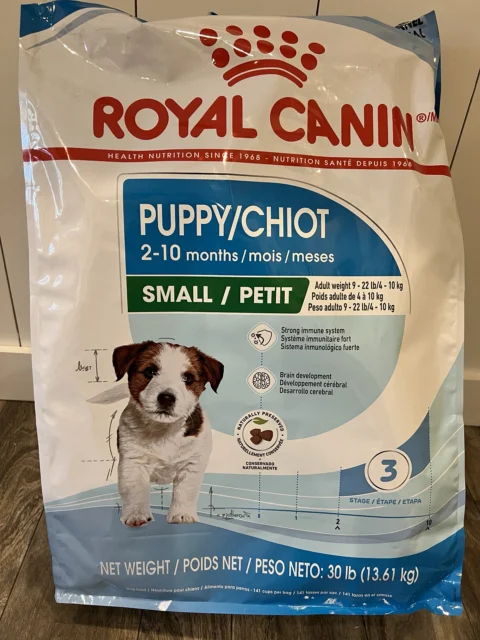
How many meals a day do Mini Goldendoodles need?
On average, you should feed your Mini Goldendoodle two to three times each day. They should eat around 1 ½ to 2 cups of food per day, which means ¾ to 1 cup per meal, depending on how often you feed your Mini Goldendoodle.
When do you transition Mini Goldendoodles from puppy food to adult food?
The best time to transition Mini Goldendoodles from puppy food to adult food is when they reach adulthood. In most cases, this is around the nine to twelve-month mark, so anywhere in that range is acceptable.
Generally, switching Mini Goldendoodles to adult food has little to no effect on them. If anything, the only thing you’ll notice is that they have slightly less energy because adult dog food doesn’t have quite as much protein as puppy food.
If you don’t want to worry about switching your dog from puppy food to adult food, Purina Pro Plan carries an “all stages of life” dog food. As the name indicates, you can feed this food to your Mini Goldendoodle as a puppy and as an adult.
However, it’s important that your adult Goldendoodle gets plenty of exercise, as they’ll be prone to obesity, due to the high concentration of protein in this food.
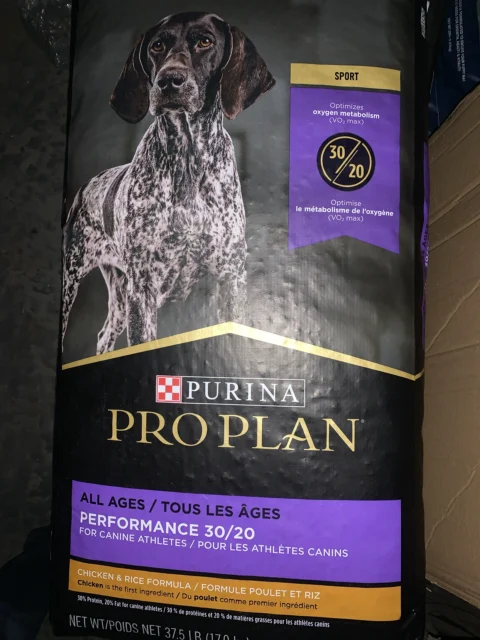
What do people on Reddit think about how big Mini Goldendoodles get?
In addition to our professional experience as Mini Goldendoodle breeders, we like to hear what the general public has to say about Mini Goldendoodle sizes based on their personal experiences. Here’s what a few helpful Reddit users had to say:
“We found this calculator to be very accurate, using it many times during our puppy’s first year.
Our guy is 23lbs now but his weight gain slowed down around 8 months when he was 20lbs. He was 21lbs at 1 year. He is currently a healthy weight for his size as well.”
“I also found this calculator to be super accurate. Mine was supposed to be a medium but every time I put in her weight it kept giving me weights that were more in line with a mini, and I thought it had to be wrong. Turns out my medium is a mini haha.”
For more helpful information from Mini Goldendoodle owners, check out this thread.
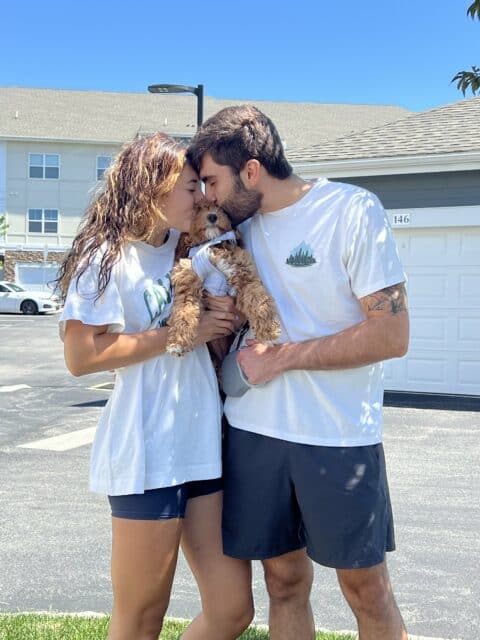
Final thoughts
While most Mini Goldendoodles, on average, stop growing at around 9 to 12 months old and typically max out at 25 to 35 pounds, this isn’t set in stone. There’s always a chance that your Mini Goldendoodle will be bigger or smaller than this, and will stop growing sooner or later.
However, while you can’t control when you pup stops growing or how big they get, you can control how healthy they are. The best way to do that is by giving them plenty of exercise and feeding them a high-quality dog food.
That way, no matter how big your Mini Goldendoodle gets or how long he or she keeps growing, they’ll live long, happy, and healthy lives.

